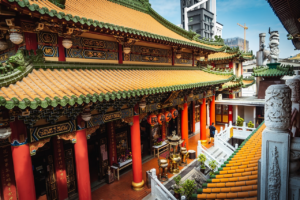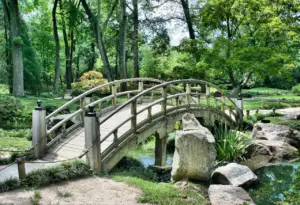Are you fascinated by different cultures and the way they express their beliefs and spirituality through architecture? Then you’ll want to explore Taiwanese religious architecture, specifically temples and shrines.
Religion has played an important role in Taiwanese culture for centuries, and the country is home to a diverse range of temples and shrines that reflect this history and the beliefs of the Taiwanese people. Taiwanese temples are known for their intricate designs, bright colors, and unique architectural styles.
Whether you’re walking through bustling cities or exploring rural areas, you’re likely to come across a temple or shrine that captures your attention. These structures are not only visually stunning but also hold significant cultural and spiritual significance.
By taking the time to visit these temples and shrines, you can gain a deeper understanding of Taiwanese culture and the role that religion plays in the lives of its people.
Key Takeaways
- Taiwanese culture deeply influenced by religion, with temples and shrines playing a significant role.
- Taiwanese temples known for intricate designs, bright colors, and unique architectural styles.
- Incense and offerings essential elements in Taiwanese religious practices, believed to attract the attention of deities and establish a connection between physical and spiritual worlds.
- Exploring Taiwanese religious architecture and traditions can provide a deeper understanding of Taiwanese culture.
The Importance of Religion in Taiwanese Culture
You can’t help but feel the deep reverence and devotion that religion holds in Taiwanese culture. From the brightly colored temples scattered throughout the cities to the elaborate shrines found in every neighborhood, religion is a fundamental aspect of daily life in Taiwan.
For many Taiwanese, religion not only provides a sense of purpose and guidance, but it also connects them to their ancestors and helps them maintain a sense of continuity with their cultural heritage.
The influence of religion can be seen in everything from the food that’s eaten to the way that people interact with each other. It’s not uncommon to see people burning incense and offering food at a nearby temple or shrine, or to witness a colorful procession celebrating a particular god or goddess.
Religion is so deeply ingrained in Taiwanese culture that it’s impossible to fully understand the country without exploring its religious architecture and traditions.
The Architecture of Taiwanese Temples
If you’re in Taiwan, chances are you’ll come across some stunning structures that showcase the country’s rich cultural heritage. Taiwanese temples are a prime example of this. The architecture of these temples is both intricate and grand, with vibrant colors and detailed carvings that tell stories of the country’s history and mythology.
Taiwanese temples are often built in a traditional style that dates back to the Ming and Qing dynasties. They’re typically constructed with wood and feature a series of curved roofs, which are adorned with beautiful tiled patterns. The temples are also decorated with ornate sculptures, including dragons, lions, and other mythical creatures.
Overall, the architecture of Taiwanese temples is a testament to the skill and creativity of the country’s artisans, and a reflection of the importance of religion in Taiwanese culture.
The Significance of Taiwanese Shrines
In this section, you’ll learn about the significance of Taiwanese shrines. You’ll discover the different types of shrines and their functions, including their use for ancestor worship and other spiritual practices.
You’ll also explore the use of incense and offerings in Taiwanese shrines and their relationship with temples in Taiwanese religious culture.
Types of Shrines and Their Functions
Explore the different types of shrines and their unique functions, giving you a deeper understanding of Taiwanese religious architecture.
In Taiwan, there are various types of shrines built to honor different deities, ancestors, and spirits. Each shrine has its own distinct purpose and significance in Taiwanese culture.
Here are some of the most common types of shrines and their functions:
-
Ancestral shrines: These shrines are built to honor the ancestors of a family or a community. They are usually located within a family’s home or a village and are used for ancestor worship ceremonies.
-
Community shrines: These shrines are built for the worship of local deities and are located in public spaces like parks or street corners. They are used for community events and festivals and are often decorated with colorful lanterns and flowers.
-
Taoist shrines: These shrines are dedicated to Taoist deities and are usually built in Taoist temples. They are used for rituals and ceremonies performed by Taoist priests. Taoist shrines are often adorned with intricate carvings and murals depicting Taoist mythology.
The Use of Incense and Offerings
Get ready to immerse yourself in the sensory experience of Taiwanese religious practices as we discuss the use of incense and offerings in shrines and temples. Incense and offerings are essential elements in Taiwanese religious practices, as they are believed to attract the attention of deities and establish a connection between the physical and spiritual worlds.
In Taiwanese temples and shrines, it is common to see altars filled with offerings such as fruits, flowers, and food items such as rice, meat, and vegetables. These offerings are meant to show respect and gratitude to the deities and spirits, who are believed to bless the devotees with good fortune, health, and protection. The use of incense is also significant in Taiwanese religious practices, as it is believed to purify the surroundings and create a pleasant aroma that the deities enjoy. The smoke from the incense is thought to carry the prayers and wishes of the devotees to the heavens, making it an important aspect of the worship.
| Incense | Offerings |
|---|---|
| Made from sandalwood, musk, and other natural ingredients | Fruits such as oranges, bananas, and apples |
| Believed to purify the surroundings and attract the attention of deities | Flowers such as lotus, chrysanthemum, and jasmine |
| Smoke carries the prayers and wishes of the devotees to the heavens | Food items such as rice, meat, and vegetables |
| Burned in special censers or holders | Meant to show respect and gratitude to the deities and spirits |
By understanding the significance of incense and offerings in Taiwanese religious practices, visitors can gain a deeper appreciation for the culture and traditions of the country. When visiting a temple or shrine, it is important to be respectful and follow the customs of the locals. As you witness the burning of incense and the placement of offerings on the altars, take a moment to reflect on the spiritual significance of these practices and the role they play in the lives of the Taiwanese people.
The Relationship Between Shrines and Temples
Experience the deep connection between shrines and temples as they intertwine to create a spiritual haven for devotees. In Taiwanese religious architecture, shrines and temples are often found in close proximity to each other, with the former serving as a smaller, more intimate space for worship and the latter as a larger, more grandiose structure for communal gatherings. However, the relationship between the two goes beyond just physical proximity.
Here are three ways in which shrines and temples are interconnected in Taiwanese religious culture:
-
Many temples have a dedicated shrine within their premises, often located at the back or side of the main hall. This shrine is usually dedicated to a specific deity or spirit, and serves as a more private space for devotees to offer their prayers and make offerings.
-
Shrines and temples often share the same set of deities, with the former serving as a more localized representation of the latter. For example, a temple dedicated to the goddess Mazu may have a shrine dedicated to her in a nearby village, where she’s worshipped as a more personal and approachable deity.
-
In some cases, a shrine may be elevated to the status of a temple if it gains enough popularity and support from the local community. This is often seen in cases where a particular deity or spirit is believed to have performed miracles or answered prayers, and thus attracts a large following of devotees.
Must-Visit Temples in Taiwan
If you’re planning a trip to Taiwan, you won’t want to miss these must-visit temples!
First up is the Longshan Temple in Taipei. It has been an important center of worship for over 200 years.
Another must-see is the Fo Guang Shan Monastery in Kaohsiung. It is one of the largest Buddhist monasteries in the world.
Finally, don’t forget to visit Xingtian Temple in Taipei. It is dedicated to Guan Yu, the god of war and martial arts.
Longshan Temple in Taipei
You’ll be immersed in a beautifully ornate and historic atmosphere when entering Longshan Temple in Taipei. This temple, built in 1738, has been through multiple natural disasters and renovations, but has stood the test of time as one of the most popular temples in Taiwan.
The main hall of the temple is dedicated to Guanyin, the Goddess of Mercy, and is adorned with intricate carvings and statues. You’ll also find a variety of other deities, including Matsu, the Goddess of the Sea, and the Emperor of Jade, all with their own unique altars and offerings.
As you make your way through the temple, you’ll notice the intricate details and symbols that hold significant meaning in Taiwanese culture. The dragon pillars, for example, represent power and strength, while the phoenix statues symbolize peace and harmony.
You may also witness locals performing traditional rituals, such as lighting incense and making offerings, adding to the spiritual energy of the temple. Whether you’re a religious person or not, visiting Longshan Temple is a must when exploring Taiwanese religious architecture and history.
Fo Guang Shan Monastery in Kaohsiung
When visiting Kaohsiung, make your way to the Fo Guang Shan Monastery to marvel at the grandeur of the Buddha Memorial Center and learn about the teachings of Buddhism. This impressive complex is one of the largest Buddhist monasteries in Taiwan, and it offers an unparalleled experience for those interested in exploring the country’s religious architecture.
As you wander through the grounds of the Fo Guang Shan Monastery, take the time to appreciate the intricate details of the buildings and the serene atmosphere that surrounds you. Here are some highlights you won’t want to miss:
-
The towering statue of Buddha that stands at the entrance of the Buddha Memorial Center
-
The exhibition halls that showcase Buddhist art, history, and teachings
-
The meditation halls where visitors can take a moment to reflect and find inner peace
-
The vegetarian restaurant that serves delicious, healthy meals made with fresh ingredients from the monastery’s own organic farm
Visiting the Fo Guang Shan Monastery is an unforgettable experience that will leave you with a deeper appreciation for Buddhism and the role it plays in Taiwanese culture.
Xingtian Temple in Taipei
To fully immerse yourself in Taipei’s rich cultural heritage, don’t miss the chance to visit Xingtian Temple, a popular spot for locals and visitors alike. This stunning temple is dedicated to the god of war and is known for its impressive architecture. The temple’s prominent red pillars and intricate roof decorations make it a sight to behold.
Located in the bustling eastern district of Taipei, Xingtian Temple is often bustling with activity. Visitors can witness locals offering prayers and burning incense as a sign of their devotion. The temple also hosts a variety of events throughout the year, including lantern festivals and traditional performances, adding to the overall cultural experience.
Make sure to add Xingtian Temple to your Taipei itinerary for a unique and memorable experience.
Hidden Gems: Lesser-Known Temples and Shrines
Visitors to Taiwan may be surprised to discover a plethora of hidden gems when it comes to exploring lesser-known temples and shrines. While the Xingtian Temple in Taipei is one of the most famous religious sites in Taiwan, there are many other temples and shrines located throughout the country that are just as impressive, if not more so.
One such temple is the Wenchang Temple in Taichung, which is dedicated to the God of Literature and attracts many visitors seeking academic success. Another hidden gem is the Zhongyuan Temple in Tainan, which is known for its intricate wood carvings and stunning architecture. No matter where you go in Taiwan, there is sure to be a temple or shrine waiting to be discovered and explored.
| Temple Name | Location | Unique Feature |
|---|---|---|
| Wenchang Temple | Taichung | Dedicated to the God of Literature |
| Zhongyuan Temple | Tainan | Intricate wood carvings and stunning architecture |
| Longshan Temple | Lukang | Built during the Qing Dynasty |
| Guan Gong Temple | Kaohsiung | Dedicated to Guan Gong, the God of War |
Each temple and shrine offers a unique experience and insight into Taiwanese culture and beliefs. Take the time to visit these hidden gems and appreciate the beauty and history they hold.
Exploring Religious Festivals and Celebrations
As you explore the religious culture of Taiwan, you’ll soon discover the importance of three major celebrations.
Firstly, Lunar New Year is a major celebration that marks the beginning of the lunar calendar. It’s observed with family gatherings, traditional foods, and temple visits.
Secondly, Ghost Month is a time when the spirits of the dead are believed to roam the earth. Various rituals are performed to appease them.
Lastly, the Mazu Pilgrimage honors the goddess of the sea. It attracts thousands of devotees who embark on a journey to her temple in a grand procession.
Lunar New Year
You’ll definitely want to check out the festive Lunar New Year decorations at the temples and shrines around Taiwan. This holiday is a big deal in Taiwan, and you’ll see that reflected in the vibrant and colorful displays that adorn the religious architecture. It’s a great opportunity to experience the local culture and get a feel for the importance of this holiday in Taiwanese society.
When visiting the temples and shrines during Lunar New Year, here are a few things to keep in mind:
-
Be prepared for crowds. This is a popular time for locals and tourists alike to visit these places of worship, so expect large crowds and long lines.
-
Respect the customs and traditions. Lunar New Year is a time for prayer and offerings, so be mindful of those who are there for religious purposes and observe the appropriate etiquette.
-
Take your time and soak it all in. The decorations and festivities are truly a sight to behold, so don’t rush through your visit. Take the time to appreciate the beauty and significance of these religious landmarks during this special time of year.
Ghost Month
Don’t miss out on the eerie and fascinating Ghost Month traditions in Taiwan! Ghost Month falls on the seventh month of the lunar calendar and is a time when the spirits of the dead are believed to return to the living world.
During this month, Taiwanese people perform various rituals and offerings to appease the spirits and avoid their wrath. One of the most well-known Ghost Month traditions is the releasing of lanterns. People write the names of their deceased loved ones on lanterns and release them into the sky or water to guide the spirits back to the afterlife.
Other traditions include burning incense, lighting candles, and setting up food offerings for the ghosts. If you’re visiting Taiwan during Ghost Month, make sure to observe these traditions and respect the beliefs of the locals.
Mazu Pilgrimage
If you’re lucky enough to witness it, the Mazu Pilgrimage is a colorful and lively procession honoring the goddess Mazu, who is believed to protect fishermen and seafarers. This annual event takes place in Taiwan and attracts thousands of devotees from all over the world.
The pilgrimage usually starts in the early morning and lasts for several days, with participants carrying a statue of Mazu on their shoulders and walking through the streets of various cities and towns.
The Mazu Pilgrimage is not only a religious event but also a cultural one. It showcases the rich history and traditions of Taiwan, as well as the devotion of its people to their beliefs.
During the procession, you can see colorful banners, traditional costumes, and hear the sound of drums and gongs. It’s a truly unique experience that you won’t forget anytime soon.
The Future of Taiwanese Religious Architecture
The evolution of Taiwanese religious architecture is sure to continue as new generations infuse their own creative ideas and preferences into the construction of temples and shrines.
While traditional styles and designs will always hold a significant place in Taiwanese culture, modernization and globalization will undoubtedly play a role in shaping the future of religious architecture.
As you explore the temples and shrines of Taiwan, you may find yourself contemplating the balance between preserving tradition and embracing change.
The future of religious architecture in Taiwan is a complex and multi-faceted topic, but it’s certain that the next generation of architects and artisans will continue to create stunning, thought-provoking structures that reflect the unique blend of culture, tradition, and innovation that characterizes modern-day Taiwan.
Frequently Asked Questions
What is the history of the first Taiwanese temple and how has it evolved over time?
The history of the first Taiwanese temple dates back to the early days of Taiwan’s settlement by the Han Chinese. It was built to honor the gods and goddesses that they worshipped back in China.
Over time, the temple has evolved to reflect the changing religious beliefs and practices of the Taiwanese people. Today, it remains an important center of religious and cultural life in Taiwan, attracting visitors from all over the world who come to experience its unique blend of tradition and modernity.
How do Taiwanese people typically interact with their religious architecture and what are some common practices?
When it comes to interacting with religious architecture in Taiwan, there are a few common practices that you may notice.
For starters, many people participate in prayer and offerings, often leaving fruit or incense at the temple or shrine as a symbol of respect and gratitude.
Additionally, you may see people burning joss paper or spirit money as a way of sending blessings to loved ones who have passed away.
Many temples and shrines also hold festivals and events throughout the year, which may involve parades, performances, and other cultural traditions.
Overall, Taiwanese people tend to have a deep reverence for their religious architecture and the traditions associated with it, making it an integral part of their daily lives.
What role do shrines play in Taiwanese religious belief and how do they differ from temples?
Shrines hold an important place in Taiwanese religious belief. They differ from temples in that they are typically smaller and more focused on a specific deity or purpose.
While temples may have multiple altars and a variety of gods worshipped within, shrines usually have only one or two altars dedicated to a specific deity or ancestor.
Many Taiwanese people believe that shrines are a place where they can connect with their ancestors and seek guidance from them. It’s common to see people leaving offerings at shrines, such as incense, fruit, or other items that are believed to be pleasing to the deity.
Overall, shrines play a significant role in Taiwanese religious practice and are an important part of the country’s cultural heritage.
Are there any unique architectural features or styles found in Taiwanese religious buildings that are not present in other cultures?
When it comes to Taiwanese religious buildings, there are definitely some unique architectural features and styles that you won’t find in other cultures.
For example, many Taiwanese temples and shrines have ornate, multi-tiered roofs with intricate carvings and colorful tiles. The use of bright colors is also a common theme, with many buildings featuring bold reds, greens, and golds.
Another interesting feature is the use of dragon and phoenix motifs, which are often carved into the building’s wooden beams or painted onto the walls.
Overall, Taiwanese religious architecture is a fascinating blend of traditional Chinese design elements and local Taiwanese influences, making it truly one-of-a-kind.
How has the modernization of Taiwan impacted the design and construction of new religious buildings?
Modernization has had a significant impact on the design and construction of new religious buildings in Taiwan.
With the development of new technologies and materials, architects and builders have more options in terms of construction methods and aesthetics.
Additionally, the influence of Western architecture has led to the creation of religious buildings that incorporate modern design elements.
This can be seen in the use of glass and steel in the construction of churches and the incorporation of modern art and sculpture in the design of Buddhist temples.
As a result, many of these new religious buildings are more visually stunning and technologically advanced than their traditional counterparts.
Conclusion
Congratulations on exploring the rich tapestry of Taiwanese religious architecture. You’ve gained a deeper understanding of the importance of religion in Taiwanese culture. The unique architecture of Taiwanese temples and the significance of Taiwanese shrines.
As you continue to explore Taiwan, make sure to visit the must-see temples such as Longshan Temple and Zushi Temple. But also take the time to discover hidden gems like the Lianchuan Temple and the Dajia Jenn Lann Temple.
Don’t miss out on the vibrant religious festivals and celebrations that take place throughout the year. Keep an eye on the future of Taiwanese religious architecture as it continues to evolve.
Happy exploring!














































































